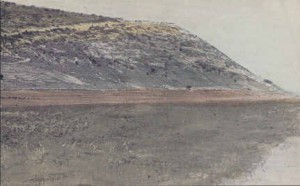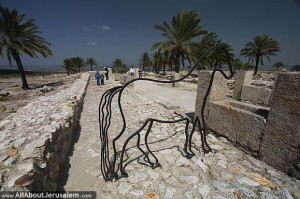The Parsha of VaYakhel could have been much, much shorter. It could have just said,
“And Moshe told the Jewish People all the things that G-d had commanded them regarding building the Mishkan (tabernacle). The Jewish People did all the things that G-d commanded.”
End of Parsha.
If it wanted to be a little more descriptive, it might have included chapter 25, the first chapter of Parshat VaYakhel. In it, Moshe first warns them about keeping Shabbat, then he tells them about all the things that need to be made, and asks for donations. We hear about how all the people donated everything that was necessary, after which it could have ended with, “And the Jewish People made all the things that G-d commanded.”
End of Parsha.
Instead, we have chapters 26, 27, and 28, which are in the format of:
“He made fifty golden hooks…”
“He made goatskin curtains …”
“He made wooden boards…”
“He made a woven hanging for the entrance…”
and so on, thirty-odd times[1].
The Haftarah has a similar format. The chapter of Melachim that is read for the Haftarah describes the making of the objects needed in the Temple. Here too, the list is very detailed, including objects like pots, shovels, nets, and basins. Here too, this chapter (of which the Sefardim read one subset of verses and Ashkenazim another) repeats the word “he made”, ויעש, many times[2]. The Haftarah that we read is even known by its first few words, “ויעש חירם”, “Hiram made”, referring to the chief craftsman of the project.
Hence we see that both in the Parsha and the Haftarah, there is an emphasis on the detailed craftwork that was required for the various objects needed in the Temple, with a specific emphasis on the craftsman.
Why is this important?
Pulpit rabbis and Bar Mitzvah boys who find themselves having to give a speech about this Parsha tend to find refuge in its first few verses. Moshe gathers the people, and the first thing he does, as we mentioned earlier, is tell them that they must keep Shabbat.
(א) וַיַּקְהֵל מֹשֶׁה אֶת כָּל עֲדַת בְּנֵי יִשְׂרָאֵל וַיֹּאמֶר אֲלֵהֶם אֵלֶּה הַדְּבָרִים אֲשֶׁר צִוָּה ה’ לַעֲשֹׂת אֹתָם:
(ב) שֵׁשֶׁת יָמִים תֵּעָשֶׂה מְלָאכָה וּבַיּוֹם הַשְּׁבִיעִי יִהְיֶה לָכֶם קֹדֶשׁ שַׁבַּת שַׁבָּתוֹן לַה’ כָּל הָעֹשֶׂה בוֹ מְלָאכָה יוּמָת:
1) Moshe gathered the entire congregation of Bnei Israel; he said to them, these are the things that Hashem has commanded you to do:
2) Six days you will do melacha[3], and the seventh day will be holy, Shabbat-Shabbaton to Hashem; whoever does melacha will be put to death. (Shemot 35)
Keeping Shabbat means that you do melacha for six days, and during the seventh day, you do not do any melacha. What is melacha? It’s something that one does, a form of labor or work. But what kind, exactly?
A bit later in the same chapter, when the chief craftsman of the Mishkan, Betzalel, is introduced, we hear more about what it entails:
ל) וַיֹּאמֶר מֹשֶׁה אֶל בְּנֵי יִשְׂרָאֵל רְאוּ קָרָא ה’ בְּשֵׁם בְּצַלְאֵל בֶּן אוּרִי בֶן חוּר לְמַטֵּה יְהוּדָה:
לא) וַיְמַלֵּא אֹתוֹ רוּחַ אֱ-לֹהִים בְּחָכְמָה בִּתְבוּנָה וּבְדַעַת וּבְכָל מְלָאכָה:
30) Moshe said to Bnei Israel: Look, Hashem has called the name of Betzalel ben Uri ben Chur of the tribe of Yehudah.
31) He has filled him with the Spirit of G-d: with wisdom, with understanding, with knowledge, and with all melacha.
Similarly, when chief craftsman of the Temple, Hiram, is introduced (a few verses before he appears in our Haftarah[4]), it says:
יג) וַיִּשְׁלַח הַמֶּלֶךְ שְׁלֹמֹה וַיִּקַּח אֶת חִירָם מִצֹּר:
יד)….וַיִּמָּלֵא אֶת הַחָכְמָה וְאֶת הַתְּבוּנָה וְאֶת הַדַּעַת לַעֲשׂוֹת כָּל מְלָאכָה בַּנְּחֹשֶׁת וַיָּבוֹא אֶל הַמֶּלֶךְ שְׁלֹמֹה וַיַּעַשׂ אֶת כָּל מְלַאכְתּוֹ:
13) King Shlomo sent for and got Hiram of Tzor.
14) … He was filled with the wisdom, the understanding, and the knowledge to do all forms of melacha in bronze. He came to King Shlomo and he made all of his melacha.
From the juxtaposition of melacha with “wisdom, understanding, and knowledge”, we can infer that melacha refers to skilled labor, or craftsmanship. In fact, the Laws of Shabbat define melacha as the set of activities that were needed to build the Mishkan and its contents, activities that require a certain amount of skill or competence. Moreover, actions that are not done in a skillful manner do not count as melacha. Examples of this are: doing something unintentionally, having two people do a task meant for one individual, or doing something for a particular purpose and accomplishing something else as a result. In other words: if it’s done without “wisdom, understanding, and knowledge”, it is not truly melacha.
Now one might think that the fact that G-d does not want us to do melacha on the day that He made holy, on Shabbat, it means that G-d does not think very highly of this type of work, or even work in general. Perhaps the ideal for human beings is to be spiritual beings who spend their time in contemplation, rather than in activity.
But that is not the message that we get from Parshat VaYakhel. Shabbat is meant to remind us of Creation. When G-d created the world, He did not rest for seven days. Rather, He acted for six days and rested on the seventh. Human beings were created “be’tzelem Elokim”, in the image of G-d. We are His partners in Creation; He has given us power over nature, the ability to work with wood and metal to create things that nature cannot bring forth on its own. Just as He created for six days, we, too, are expected to act, to be “filled with wisdom, understanding, and knowledge”, and to create things for six days. We are then commanded to also emulate Him by holding back, by refraining from melacha, from craftwork, on the seventh day, on Shabbat. Not because melacha is not important, but because it is an expression of our godliness, of our “Tzelem Elokim”, as is Shabbat itself.
Having given us the ability to create, a portion of Himself, as it were, G-d is delighted in seeing us do so. So much so that He lists every one of the actions of craftsmanship involved in implementing the joint G-d / human project, the Mishkan.
The Ramban, in attempting to answer the question posed above, regarding the purpose of Parshat VaYakhel’s detailed repetition of the work of the Mishkan, says the following:
ועל הכלל כל זה דרך חבה ודרך מעלה, לומר כי חפץ השם במלאכה ומזכיר אותה בתורתו פעמים רבות
In general, all of this shows affection and regard, that is, that Hashem desires this melacha and mentions it in His Torah several times (Ramban, Shemot 36:8)
The reason that the Torah repeats each and every act of melacha, of creation, thirty-odd times, is that Hashem gets nachas from seeing His children act in “tzelem Elokim”, in wisdom, understanding, and knowledge.
It is precious to Him, and it should be precious to us, also.
Dedicated to the memory of Rose Alster, z”l, my grandmother (in-law), Elta Bubby to thirty-odd great-grandchildren, whose yahrtzeit was this past week, 19th Adar. She got nachas from hearing every detail of each and every one of their actions, as they were each precious to her. She is still precious to us all.
Copyright © Kira Sirote
In memory of my father, Peter Rozenberg, z”l
לעילוי נשמת אבי מורי פנחס בן נתן נטע ז”ל
[1] According to the search results of Bar-Ilan’s Morashti CD, 37 times.
[2] Seven times in the entire chapter, 2 of them in the Haftarah that we read.
[3] The word melacha was deliberately left un-translated, as it does not have a direct parallel in English. The rest of this essay attempts to pin down its precise meaning.
[4] This is the section of the chapter read by Sefardi shuls for VaYakhel. They read our section next week, for Pekudei, while we read the section after that.
Like this:
Like Loading...


